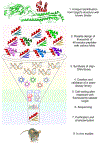De novo protein design, a retrospective
- PMID: 32041676
- PMCID: PMC7243446
- DOI: 10.1017/S0033583519000131
De novo protein design, a retrospective
Abstract
Proteins are molecular machines whose function depends on their ability to achieve complex folds with precisely defined structural and dynamic properties. The rational design of proteins from first-principles, or de novo, was once considered to be impossible, but today proteins with a variety of folds and functions have been realized. We review the evolution of the field from its earliest days, placing particular emphasis on how this endeavor has illuminated our understanding of the principles underlying the folding and function of natural proteins, and is informing the design of macromolecules with unprecedented structures and properties. An initial set of milestones in de novo protein design focused on the construction of sequences that folded in water and membranes to adopt folded conformations. The first proteins were designed from first-principles using very simple physical models. As computers became more powerful, the use of the rotamer approximation allowed one to discover amino acid sequences that stabilize the desired fold. As the crystallographic database of protein structures expanded in subsequent years, it became possible to construct proteins by assembling short backbone fragments that frequently recur in Nature. The second set of milestones in de novo design involves the discovery of complex functions. Proteins have been designed to bind a variety of metals, porphyrins, and other cofactors. The design of proteins that catalyze hydrolysis and oxygen-dependent reactions has progressed significantly. However, de novo design of catalysts for energetically demanding reactions, or even proteins that bind with high affinity and specificity to highly functionalized complex polar molecules remains an importnant challenge that is now being achieved. Finally, the protein design contributed significantly to our understanding of membrane protein folding and transport of ions across membranes. The area of membrane protein design, or more generally of biomimetic polymers that function in mixed or non-aqueous environments, is now becoming increasingly possible.
Keywords: Protein design.
Figures














Similar articles
-
De Novo Design of Four-Helix Bundle Metalloproteins: One Scaffold, Diverse Reactivities.Acc Chem Res. 2019 May 21;52(5):1148-1159. doi: 10.1021/acs.accounts.8b00674. Epub 2019 Apr 11. Acc Chem Res. 2019. PMID: 30973707 Free PMC article.
-
Bottom-up de novo design of functional proteins with complex structural features.Nat Chem Biol. 2021 Apr;17(4):492-500. doi: 10.1038/s41589-020-00699-x. Epub 2021 Jan 4. Nat Chem Biol. 2021. PMID: 33398169
-
A generic framework for hierarchical de novo protein design.Proc Natl Acad Sci U S A. 2022 Oct 25;119(43):e2206111119. doi: 10.1073/pnas.2206111119. Epub 2022 Oct 17. Proc Natl Acad Sci U S A. 2022. PMID: 36252041 Free PMC article.
-
Designing hydrolytic zinc metalloenzymes.Biochemistry. 2014 Feb 18;53(6):957-78. doi: 10.1021/bi4016617. Epub 2014 Feb 7. Biochemistry. 2014. PMID: 24506795 Free PMC article. Review.
-
An accurate binding interaction model in de novo computational protein design of interactions: if you build it, they will bind.J Struct Biol. 2014 Feb;185(2):136-46. doi: 10.1016/j.jsb.2013.03.012. Epub 2013 Apr 1. J Struct Biol. 2014. PMID: 23558036 Review.
Cited by
-
A defined structural unit enables de novo design of small-molecule-binding proteins.Science. 2020 Sep 4;369(6508):1227-1233. doi: 10.1126/science.abb8330. Science. 2020. PMID: 32883865 Free PMC article.
-
De novo design of a nanopore for single-molecule detection that incorporates a β-hairpin peptide.Nat Nanotechnol. 2022 Jan;17(1):67-75. doi: 10.1038/s41565-021-01008-w. Epub 2021 Nov 22. Nat Nanotechnol. 2022. PMID: 34811552 Free PMC article.
-
CC+ : A searchable database of validated coiled coils in PDB structures and AlphaFold2 models.Protein Sci. 2023 Nov;32(11):e4789. doi: 10.1002/pro.4789. Protein Sci. 2023. PMID: 37768271 Free PMC article.
-
Data hazards in synthetic biology.Synth Biol (Oxf). 2024 Jun 21;9(1):ysae010. doi: 10.1093/synbio/ysae010. eCollection 2024. Synth Biol (Oxf). 2024. PMID: 38973982 Free PMC article. Review.
-
Generative β-hairpin design using a residue-based physicochemical property landscape.Biophys J. 2024 Sep 3;123(17):2790-2806. doi: 10.1016/j.bpj.2024.01.029. Epub 2024 Feb 1. Biophys J. 2024. PMID: 38297834 Free PMC article.
References
-
- Adamian L and Liang J (2001) Helix–helix packing and interfacial pairwise interactions of residues in membrane proteins. Journal of Molecular Biology 311, 891–907. - PubMed
-
- Adamian L and Liang J (2002) Interhelical hydrogen bonds and spatial motifs in membrane proteins: polar clamps and serine zippers. Proteins 47, 209–218. - PubMed
-
- Åkerfeldt K, Kim RM, Camac D, Groves JT, Lear JD and DeGrado WF (1992) Tetraphilin: a four-helix proton channel built on a tetraphenylporphyrin framework. Journal of the American Chemical Society 114, 9656–9657.
Publication types
MeSH terms
Substances
Grants and funding
LinkOut - more resources
Full Text Sources
Other Literature Sources
Research Materials

